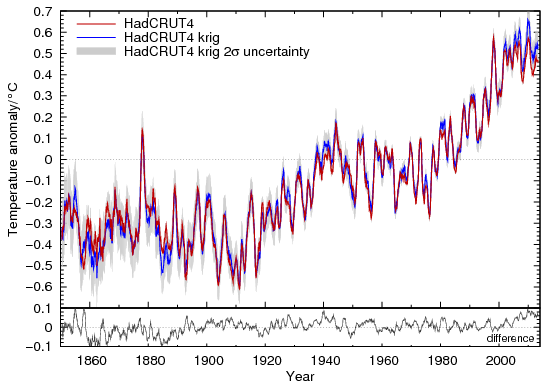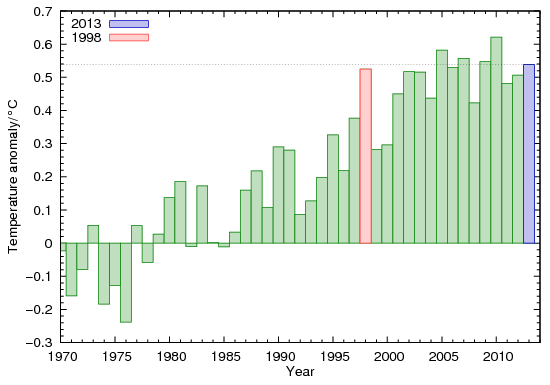
Following the release of temperature data for December 2013, we have updated our temperature series to include another year. From now on we hope to provide monthly updates. In addition we have released the first of a new set of 'version 2' temperature reconstructions.
One of the main limitations of Cowtan and Way (in press), which we highlighted in the paper and has been echoed by others, is that the global temperature reconstruction was performed on the blended land-ocean data. The problem with this approach is that surface air temperatures behave differently over land and ocean, primarily due to the thermal inertia and mixing of the oceans. The problem is compounded by the fact that sea surface temperatures are used as a proxy for marine air temperatures due to problems in the measurement of marine air temperatures.
We have therefore started releasing temperature series based on separate reconstruction of the land and ocean data. The first of these 'version 2' temperature series is a long reconstruction covering the period from 1850 to the present, infilled by kriging the HadCRUT4 land and ocean ensembles. (We can't produce a hybrid reconstruction back to 1850 because the satellite data only starts in 1979.)
For the long reconstruction there is no need to rebaseline the data to match the UAH data, and so all the original observations may be used. The separate land/ocean reconstructions also address a small bias due to changing land and ocean coverage which was mitigated by the rebaselining step in our previous work.
The use of the ensemble data means that we now produce a more comprehensive estimate of the uncertainty in the temperature estimates (following Morice et al 2012). The coverage uncertainty estimate has also been upgraded to capture some of the seasonal cycle in the uncertainty. A comparison of the temperature series to the official HadCRUT4 values is shown in Figure 1.

Figure 1: Comparison of HadCRUT4 to the infilled reconstruction, using a 12 month moving average.
We have also updated the version 1 infilled and hybrid reconstructions to the end of 2013. These will be frozen at that point and replaced by new version 2 hybrid reconstructions.
The annual temperature averages for the version 2 infilled data are shown in Figure 2.

Figure 2: Annual temperatures for the version 2 infilled reconstruction
Rankings of the hottest years are as follows:
| Rank | HadCRUT4 | Version 2 infilled | Version 1 hybrid |
| 1 | 2010 | 2010 | 2010 |
| 2 | 2005 | 2005 | 2005 |
| 3 | 1998 | 2007 | 2009 |
| 4 | 2003 | 2009 | 2007 |
| 5 | 2006 | 2013 | 2013 |
| 6 | 2009 | 2006 | 2002 |
| 7 | 2002 | 1998 | 2006 |
| 8 | 2013 | 2002 | 2012 |
| 9 | 2007 | 2003 | 2003 |
| 10 | 2012 | 2012 | 1998 |
2013 is the 5th hottest year according to both the version 2 infilled data and the version 1 hybrid data. This compares to 8th for HadCRUT4, 7th for GISTEMP and 4th for NCDC, although in many cases the years are statistical ties.
The ranking of 2013 in comparison to 1998 is particularly interesting. HadCRUT4, GISTEMP and NCDC all show 2013 as cooler than 1998, which was an exceptional El Niño year. However both of our reconstructions show 2013 to be warmer than 1998, despite 2013 being El Niño neutral.
A caveat is required for the version 2 infilled reconstruction: This purpose of this temperature reconstruction is to provide realistic temperature estimates for the whole of the 20th century, and so the ice mask does not capture the recent decline in Arctic sea ice. Low ice cover will affect results since 2007. This will be addressed in future updates.
We plan to release six new satellite era reconstructions over the next few weeks. We have a further update planned for February which will address the question of why our trends are greater than those for GISTEMP over recent years.
Data and documentation are available from the project website.
Posted by Kevin C on Monday, 27 January, 2014
 |
The Skeptical Science website by Skeptical Science is licensed under a Creative Commons Attribution 3.0 Unported License. |